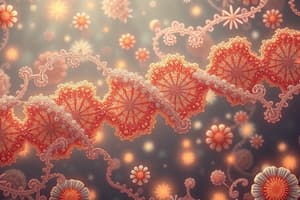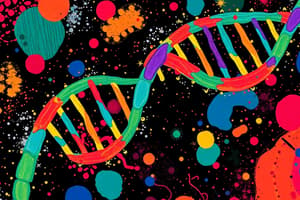Podcast
Questions and Answers
What does the central dogma of molecular biology describe?
What does the central dogma of molecular biology describe?
- The synthesis of amino acids from nucleotides
- The structure and function of genes in genomes
- The conversion of genetic information from DNA to RNA to protein (correct)
- The process of RNA replication
Which statement correctly describes the relationship between genes and genomes?
Which statement correctly describes the relationship between genes and genomes?
- Two genes together make up a genome.
- A gene is a complete set of nuclear DNA in a cell.
- A genome includes all coding and non-coding DNA, whereas a gene is a segment of DNA. (correct)
- Genomes are exclusively composed of coding DNA.
What is a defining characteristic of a gene compared to a genome?
What is a defining characteristic of a gene compared to a genome?
- A gene can be several million base pairs long.
- A gene serves as a structural unit of heredity. (correct)
- A genome cannot contain duplicate alleles.
- A gene is defined only by its non-coding regions.
In the context of genetics, what does the term 'alleles' refer to?
In the context of genetics, what does the term 'alleles' refer to?
What distinguishes the study of genes from the study of genomes?
What distinguishes the study of genes from the study of genomes?
Which statement accurately reflects the relationship between nucleotides in a gene and amino acids in the encoded protein?
Which statement accurately reflects the relationship between nucleotides in a gene and amino acids in the encoded protein?
What are exons primarily characterized by?
What are exons primarily characterized by?
Which of the following is NOT a characteristic of introns?
Which of the following is NOT a characteristic of introns?
What happens to introns during the process of gene expression in eukaryotic cells?
What happens to introns during the process of gene expression in eukaryotic cells?
Which statement about eukaryotic genes is true regarding introns and exons?
Which statement about eukaryotic genes is true regarding introns and exons?
Which RNA polymerase is responsible for transcribing the 5.8S, 18S, and 28S rRNA genes?
Which RNA polymerase is responsible for transcribing the 5.8S, 18S, and 28S rRNA genes?
What is the role of the TATA box in eukaryotic transcription?
What is the role of the TATA box in eukaryotic transcription?
Which basal transcription factor is the first to bind to the TATA box during transcription initiation?
Which basal transcription factor is the first to bind to the TATA box during transcription initiation?
When eukaryotic protein-coding genes lack a TATA box, what alternative element may be present?
When eukaryotic protein-coding genes lack a TATA box, what alternative element may be present?
What is the primary function of RNA polymerase II within the nucleus?
What is the primary function of RNA polymerase II within the nucleus?
What is the approximate position of the TATA box relative to the transcription start site?
What is the approximate position of the TATA box relative to the transcription start site?
In eukaryotic transcription, what sequence is primarily recognized by RNA polymerase II at the promoter site?
In eukaryotic transcription, what sequence is primarily recognized by RNA polymerase II at the promoter site?
Which rRNA genes are transcribed by RNA polymerase I?
Which rRNA genes are transcribed by RNA polymerase I?
What type of RNA is synthesized by RNA polymerase II?
What type of RNA is synthesized by RNA polymerase II?
What is the significance of the 'S' values assigned to rRNAs?
What is the significance of the 'S' values assigned to rRNAs?
Which of the following best describes the structure of eukaryotic RNA polymerases?
Which of the following best describes the structure of eukaryotic RNA polymerases?
What role do transcription factors play in eukaryotic transcription?
What role do transcription factors play in eukaryotic transcription?
How does eukaryotic transcription differ from prokaryotic transcription?
How does eukaryotic transcription differ from prokaryotic transcription?
Which of the following is true concerning the primary transcript produced during transcription?
Which of the following is true concerning the primary transcript produced during transcription?
Which type of RNA is specifically associated with RNA polymerase III?
Which type of RNA is specifically associated with RNA polymerase III?
Flashcards
Central Dogma
Central Dogma
The central dogma describes the flow of genetic information from DNA to RNA to protein. It's the process of converting DNA's information into a functional product.
Genome
Genome
A genome is the entire set of genetic instructions for an organism, including all coding and non-coding DNA. It encompasses all genes.
Gene
Gene
A gene is a segment of DNA that provides instructions for making a specific RNA or protein. It's the basic unit of heredity.
Genetics
Genetics
Signup and view all the flashcards
Genomics
Genomics
Signup and view all the flashcards
Colinearity
Colinearity
Signup and view all the flashcards
Introns
Introns
Signup and view all the flashcards
Exons
Exons
Signup and view all the flashcards
RNA splicing
RNA splicing
Signup and view all the flashcards
Non-coding vs. coding DNA
Non-coding vs. coding DNA
Signup and view all the flashcards
What does RNA polymerase I transcribe?
What does RNA polymerase I transcribe?
Signup and view all the flashcards
What does RNA polymerase II transcribe?
What does RNA polymerase II transcribe?
Signup and view all the flashcards
What does RNA polymerase III transcribe?
What does RNA polymerase III transcribe?
Signup and view all the flashcards
How many RNA polymerases are in eukaryotic cells?
How many RNA polymerases are in eukaryotic cells?
Signup and view all the flashcards
Define Transcription
Define Transcription
Signup and view all the flashcards
What is the first step in gene expression?
What is the first step in gene expression?
Signup and view all the flashcards
What is a primary transcript?
What is a primary transcript?
Signup and view all the flashcards
How does eukaryotic transcription differ from bacterial transcription?
How does eukaryotic transcription differ from bacterial transcription?
Signup and view all the flashcards
RNA polymerase I
RNA polymerase I
Signup and view all the flashcards
RNA polymerase II
RNA polymerase II
Signup and view all the flashcards
RNA polymerase III
RNA polymerase III
Signup and view all the flashcards
Promoter site
Promoter site
Signup and view all the flashcards
TATA box
TATA box
Signup and view all the flashcards
Basal transcription factors
Basal transcription factors
Signup and view all the flashcards
TBP (TATA box binding protein)
TBP (TATA box binding protein)
Signup and view all the flashcards
Study Notes
Molecular Biology I - Lecture 6: Gene Expression in Eukaryotes
- The central dogma of molecular biology illustrates the flow of genetic information from DNA to RNA to protein.
- DNA information is converted into a functional product.
- Transcription is the process where DNA is transcribed into RNA.
- In eukaryotes, the RNA transcript (pre-mRNA) is processed (spliced and modified) to become mRNA, which exits the nucleus and enters the cytoplasm.
- Amino acids are activated, attached to tRNA molecules, which then bring them to the ribosome.
- During translation, tRNAs add amino acids to a growing polypeptide chain as the mRNA is moved through the ribosome.
- A gene is a segment of DNA that provides the instructions for making gene products (like RNA or proteins).
- The genome includes all the DNA in an organism's nucleus (coding and non-coding DNA) and also the DNA in organelles like mitochondria.
- A gene is composed of a few hundred base pairs, while a genome has millions of base pairs.
- Genes have coding regions (exons) and noncoding regions (introns).
- Introns are removed during RNA processing.
- Introns are common in eukaryotic genes but are rare in bacterial genes.
- Eukaryotes have three RNA polymerases, each responsible for transcribing different types of RNA. RNA polymerase I transcribes rRNA genes, RNA polymerase II transcribes mRNA genes, and RNA polymerase III transcribes tRNA and 5S rRNA genes.
- Eukaryotic RNA polymerases require transcription factors to initiate transcription.
- Transcription in eukaryotes occurs within the nucleus.
- The basic mechanism of RNA synthesis in eukaryotes is divided into initiation, elongation, and termination phases.
- The initiation phase involves RNA polymerase recognizing the promoter site, and RNA polymerase II requires transcription factors such as TFIID, TFIIB, TFIIA, TFIIE, TFIIF and TFIIH to recognize and bind to the promoter region.
- During the elongation phase, the RNA polymerase moves along the DNA template, synthesizing RNA in the 5' to 3' direction.
- The termination phase is when the RNA chain stops, and the primary transcript is released.
Studying That Suits You
Use AI to generate personalized quizzes and flashcards to suit your learning preferences.
Related Documents
Description
This quiz covers key concepts from Lecture 6 of Molecular Biology I, focusing on gene expression in eukaryotes. Topics include the central dogma, transcription, RNA processing, and translation. Understand the flow of genetic information and the roles of mRNA and tRNA in protein synthesis.




